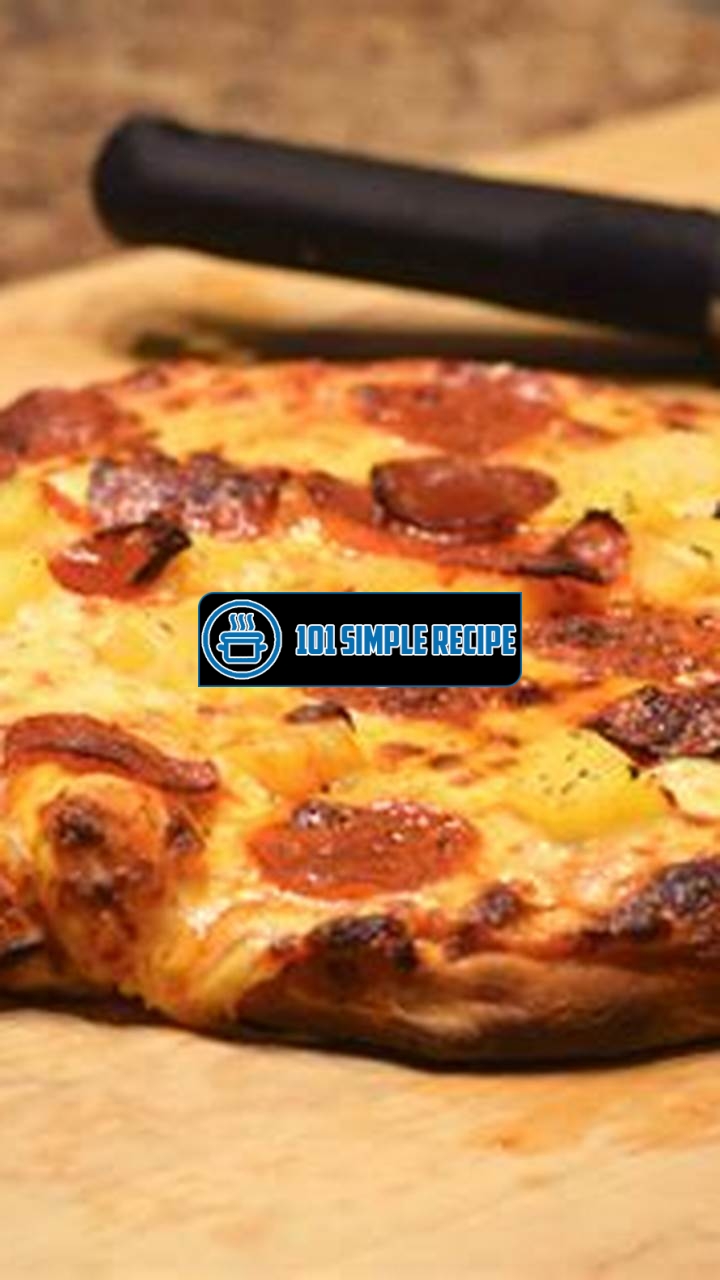Are you craving a slice of authentic New York style pizza? Look no further! This article will provide you with a foolproof recipe for making the perfect New York style pizza dough using active dry yeast. With this recipe, you can recreate the iconic chewy yet crispy crust that is synonymous with New York pizza. Whether you’re a novice in the kitchen or an experienced home cook, this recipe will guide you through the steps to achieve pizza perfection. So grab your apron and get ready to impress your friends and family with your homemade New York style pizza!

Understanding the Basics of Pizza Dough
In order to create an authentic New York style pizza dough, it’s crucial to understand the key elements that make it unique. By mastering these basics, you’ll be able to achieve that perfect balance of chewiness, crispiness, and flavor. So let’s dive into what makes this dough so special.
Choosing the Right Flour
The choice of flour plays a critical role in achieving the desired texture and taste of your pizza dough. For New York style pizza, high-gluten flour is typically used. This type of flour contains a higher protein content, which results in a chewier and more elastic dough. It provides the necessary structure to support the toppings and create that iconic foldable slice.
When selecting your flour, look for options labeled as bread flour or high-gluten flour. These are readily available at most grocery stores. Avoid using all-purpose flour or low-protein flours, as they won’t give you the same results.
The Role of Yeast in Pizza Dough
Yeast is a crucial ingredient in pizza dough as it is responsible for the fermentation process. It helps the dough rise and develop the characteristic airy texture. When using active dry yeast, it must be activated before incorporating it into the dough.
To activate the yeast, dissolve it in warm water and let it sit for a few minutes until it becomes foamy. This indicates that the yeast is alive and ready to work its magic. Adding a pinch of sugar to the water can help speed up the activation process.
Once the yeast is activated, it can be mixed with the flour and other ingredients to begin the dough-making process. Properly activated yeast will ensure a light and fluffy crust.
The Importance of Proper Kneading
Kneading is a vital step in developing the gluten in the dough, which gives it that desirable chewiness. It also helps distribute the yeast evenly throughout the dough for consistent rise and texture.
To properly knead the dough, begin by lightly flouring your work surface. Place the dough on the surface and use the heels of your hands to push it away from you, folding it back over itself. Rotate the dough a quarter turn and repeat the process. Continue kneading for about 8-10 minutes until the dough becomes smooth and elastic.
Don’t rush the kneading process as it takes time for the gluten to fully develop. This step is critical in achieving the authentic texture of New York style pizza crust.
In conclusion, understanding the basics of pizza dough is essential for creating an authentic New York style pizza. Choosing the right flour, activating the yeast, and properly kneading the dough are key components in achieving the desired texture and taste. So roll up your sleeves, gather the ingredients, and get ready to make your own delicious New York style pizza at home!
Mastering the Art of Dough Rising
When it comes to making New York style pizza dough with active dry yeast, achieving the perfect rise is essential. This process plays a crucial role in creating the light and airy texture that is synonymous with authentic New York style pizza. To help you master the art of dough rising, we have compiled some tried-and-true techniques that will ensure your pizza dough rises to perfection.
Controlling Room Temperature for Dough Rising
The room temperature plays a significant role in the rise of your pizza dough. It is recommended to maintain a warm environment, around 75 to 80 degrees Fahrenheit, to promote optimal yeast activity. When the yeast is exposed to the warmth, it activates and starts fermenting the dough, causing it to rise. To maintain the ideal temperature, you can use a proofing box or simply place your dough in a warm spot in your kitchen. Remember that too low or too high temperatures can result in a less desirable rise, so it’s crucial to find the right balance.
The Benefits of Cold Fermentation
Cold fermentation is another popular method for allowing your dough to rise. This technique involves refrigerating the dough for an extended period, typically overnight or up to 72 hours. Cold fermentation slows down the yeast activity, allowing the dough to develop more complex flavors while also creating a chewier texture. Additionally, this method enhances the dough’s extensibility, making it easier to stretch and shape into that classic New York style thin crust.
Another benefit of cold fermentation is its convenience. By preparing the dough in advance, you can have it ready to use whenever you’re craving pizza. The extended fermentation also adds depth to the overall flavor profile of the dough, resulting in a more satisfying pizza experience.
Alternative Methods for Dough Rising
While controlling room temperature and cold fermentation are the go-to techniques for achieving the perfect rise, there are a few alternative methods that you can experiment with:
- Steam rising technique: By placing a bowl of hot water in the oven while the dough is rising, you can create a humid environment that promotes yeast activity.
- Using a dough proofer: If you frequently make pizza dough, investing in a dough proofer can be a game-changer. These devices provide precise temperature and humidity control, allowing you to achieve consistent results every time.
- Optimizing yeast quantities: Experimenting with different yeast quantities can also affect the rise. Using a small amount of yeast and extending the fermentation time can lead to enhanced flavor and texture.
Remember, the key to perfecting the rise of your New York style pizza dough is to find the method that works best for you. Don’t be afraid to experiment and adjust your techniques to suit your preferences. Happy dough rising!
Creating the Perfect Crust Texture
When it comes to New York style pizza, achieving the perfect crust texture is key. The crust should be thin and crispy on the outside, yet soft and chewy on the inside. Achieving this balance requires careful attention to a few key factors.
Controlling the Gluten Development
One of the most important factors in creating the perfect crust texture is controlling the development of gluten. Gluten is a protein that gives dough its elasticity and structure. Too much gluten development can result in a tough and dense crust, while too little can lead to a floppy and limp crust.
To control gluten development, it’s important to use the right type of flour. New York style pizza dough typically calls for high-protein bread flour, which has a higher gluten content. This helps create a chewy texture. You can also add some vital wheat gluten to the dough if you want a more stretchy and elastic crust.
Another tip for controlling gluten development is to knead the dough properly. Kneading helps develop the gluten strands, but over-kneading can result in a tough crust. It’s best to knead the dough just until it’s smooth and elastic.
The Significance of Resting the Dough
Resting the dough is another crucial step in achieving the perfect crust texture. After kneading the dough, it needs time to relax and rise. This allows the gluten to relax, making the dough easier to stretch and preventing it from shrinking back during baking.
Resting the dough also enhances the flavor and texture of the crust. It gives the yeast more time to ferment the dough, resulting in a deeper and more complex flavor. It also allows the dough to develop a slightly puffy texture, which contributes to the light and airy crust characteristic of New York style pizza.
Exploring Different Baking Methods
The baking method you choose can also greatly impact the texture of your New York style pizza crust. While traditional New York style pizza is typically baked in a deck oven at a high temperature, there are other methods you can explore.
One popular alternative is baking the pizza on a pizza stone or steel. These materials absorb and distribute heat more evenly, resulting in a crispier crust. Preheating the stone or steel is crucial to achieve a golden brown crust.
Another method to consider is using a pizza screen or perforated pan. These tools allow hot air to circulate around the dough, resulting in a uniformly cooked crust with a slightly crunchy texture.
Experimenting with different baking methods can help you find the perfect balance between crispiness and chewiness for your New York style pizza crust.
Overall, achieving the perfect crust texture for a New York style pizza requires attention to detail and careful consideration of factors like gluten development, resting the dough, and baking methods. By following these tips and tricks, you’ll be well on your way to creating a delicious and authentic New York style pizza crust that will have your taste buds begging for more.
Enhancing Flavor with Seasonings and Additions
When it comes to crafting the perfect New York style pizza dough, one of the key elements is enhancing the flavor with seasonings and additions. These simple additions can elevate the taste of your dough and take your pizza to the next level. From choosing the right salt to experimenting with herbs and spices, let’s explore the various options available to you.
Choosing the Right Salt for Pizza Dough
The salt you choose can make a significant difference in the flavor of your pizza dough. While table salt is the most common option, consider exploring alternatives to enhance the taste. Kosher salt, for example, has larger grains that dissolve more slowly, resulting in a more balanced and nuanced flavor. Sea salt, on the other hand, can add a subtle briny note to your dough.
It’s important to note that different salts have varying levels of saltiness, so be sure to adjust the amount accordingly. Start with a smaller amount and adjust to taste as you go along. Don’t be afraid to experiment with different types of salt to find the perfect flavor profile for your New York style pizza dough.
Exploring the Use of Olive Oil
Olive oil is another ingredient that can greatly enhance the flavor of your pizza dough. Not only does it add a rich, savory taste, but it also helps create a crisp and tender crust. When choosing olive oil, opt for extra virgin olive oil for the best flavor. Its fruity and slightly peppery notes can add a delightful complexity to your dough.
It’s important to note that while olive oil is a great addition, it should be used in moderation. Too much oil can make the dough heavy and greasy. Start with a smaller amount and gradually add more if needed. Remember, it’s all about finding the right balance.
Experimenting with Herbs and Spices
️ Adding herbs and spices to your New York style pizza dough can take its flavor to new heights. From classic choices like basil, oregano, and garlic powder to bolder options like red pepper flakes and fennel seeds, there is a wide range of possibilities to explore.
Experimentation is key when it comes to finding the perfect combination of herbs and spices. Start by adding a small amount and taste the dough as you go along. This will allow you to adjust the flavors and achieve your desired taste. Whether you prefer a more traditional flavor profile or want to be adventurous with bold and unique combinations, don’t be afraid to let your creativity shine.
To sum it up, enhancing the flavor of your New York style pizza dough is all about exploring different seasonings and additions. From choosing the right salt to experimenting with olive oil, herbs, and spices, each ingredient can contribute to a more delicious and satisfying pizza experience. So go ahead, get creative, and elevate your pizza game to new heights!
Perfecting the Pizza Making Process
Once you have prepared your New York style pizza dough using active dry yeast, the next step is to assemble and bake your pizza to perfection. Follow these final steps to achieve a delicious and authentic New York style pizza:
Stretching and Shaping the Dough
Before you start stretching and shaping the dough, make sure it has risen properly. It should have doubled in size and be soft and pliable. Sprinkle some flour on a clean surface and place the dough on it.
To stretch the dough, use your hands to flatten it gently and then start stretching it from the center towards the edges. Rotate the dough as you stretch to ensure an even thickness. You can also use a rolling pin if you prefer a thinner crust.
Once the dough is stretched to your desired size, you can shape it into a round or rectangular shape, depending on your preference. To create the classic New York style pizza shape, fold the edges of the dough inward and pinch them together.
Emphasize the importance of gently stretching and shaping the dough to maintain its airiness and prevent it from becoming dense. This step will also help create a crispy crust.
Sauce and Cheese Selection Tips
The sauce and cheese are essential components of a New York style pizza. When it comes to sauce, opt for a simple and flavorful tomato sauce. You can use canned crushed tomatoes or tomato puree as a base and season it with salt, pepper, and herbs like oregano and basil.
For the cheese, mozzarella is the traditional choice. It provides a gooey and stringy texture when melted. You can use fresh mozzarella or low-moisture mozzarella. If you prefer a slightly tangy flavor, you can also add some grated Parmesan or pecorino cheese on top.
Highlight the importance of using high-quality ingredients for the sauce and cheese to enhance the overall flavor of the pizza.
Optimal Baking Techniques for a Crispy Crust
The key to achieving a crispy crust is a hot oven and the right baking techniques. Preheat your oven to the highest temperature it can reach, usually around 500°F (260°C) or higher. Place a pizza stone or baking sheet in the oven while it preheats to ensure it gets hot.
Once the oven is preheated, carefully transfer your assembled pizza onto the hot pizza stone or baking sheet. This will help the crust cook evenly and become crispy. Bake the pizza for about 10-12 minutes or until the crust turns golden brown and the cheese is bubbly and melty.
Note the importance of preheating the oven and using a hot pizza stone or baking sheet to achieve a crispy crust.
By following these steps and tips, you can perfect the pizza making process and enjoy a delicious New York style pizza with a crispy crust, flavorful sauce, and melty cheese. Get creative with your toppings and experiment with different combinations to create your own signature New York style pizza!
Thank you for reading this article on how to make New York style pizza dough using active dry yeast. We hope you found the recipe and tips helpful in creating your own delicious pizza at home. If you enjoyed this content, please be sure to visit our website again for more recipes and cooking inspiration. Don’t forget to bookmark our page for easy access to all of our mouthwatering recipes. Happy cooking!
Frequently Asked Questions
Here are some common questions about making New York style pizza dough:
| No. | Questions | Answers |
|---|---|---|
| 1. | What is the best flour to use for New York style pizza dough? | The best flour to use for New York style pizza dough is high-gluten flour. It provides the chewy texture that is characteristic of this style of pizza. |
| 2. | Can I use instant yeast instead of active dry yeast? | Yes, you can use instant yeast as a substitute for active dry yeast. However, you may need to adjust the amount used and the rise time of the dough. |
| 3. | How long should I let the dough rise? | The dough should be allowed to rise for at least 1-2 hours, or until it has doubled in size. This will ensure a light and airy crust. |
| 4. | Can I refrigerate the dough overnight? | Yes, refrigerating the dough overnight can actually enhance the flavor and texture. Just make sure to let it come to room temperature before shaping and baking. |
| 5. | Do I need a pizza stone to bake the pizza? | While a pizza stone can help achieve a crispy crust, it is not necessary. You can also use a baking sheet or a cast iron skillet. |
| 6. | What toppings are traditionally used on New York style pizza? | New York style pizza is typically topped with tomato sauce, mozzarella cheese, and various toppings such as pepperoni, mushrooms, and onions. |
Thank You for Reading!
We appreciate you taking the time to learn how to make New York style pizza dough using active dry yeast. We hope you enjoy experimenting with different toppings and creating your own unique pizza creations. Don’t forget to visit our website again for more delicious recipes and cooking tips. Happy baking!
Jump to Recipe
New York Style Pizza Dough Recipe with Active Dry Yeast

Learn how to make New York style pizza dough with this easy recipe using active dry yeast. Achieve the perfect chewy crust and delicious flavor at home.
- 2 1/4 teaspoons active dry yeast
- 1 teaspoon sugar
- 1 1/2 cups warm water
- 3 1/2 cups high-gluten flour
- 2 tablespoons olive oil
- 2 teaspoons salt
- In a small bowl, combine the active dry yeast, sugar, and warm water. Let it sit for about 5 minutes, or until the mixture becomes frothy.
- In a large mixing bowl, combine the high-gluten flour, olive oil, salt, and the yeast mixture. Stir until a dough forms.
- Transfer the dough to a lightly floured surface and knead for about 5-7 minutes, or until it becomes smooth and elastic.
- Place the dough in a greased bowl, cover it with a clean kitchen towel, and let it rise for at least 1-2 hours, or until it has doubled in size.
- Punch down the dough and divide it into 2 equal portions. Shape each portion into a ball and let them rest for 10 minutes.
- Preheat your oven to the highest temperature (usually 500°F or 260°C). Roll out each dough ball into a 12-inch circle and transfer it onto a baking sheet or a pizza stone. Add your desired toppings and bake for about 12 minutes, or until the crust is golden brown and the cheese is bubbly.






